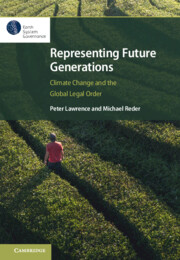
-
Select format
-
- Publisher:
- Cambridge University Press
- Publication date:
- 19 September 2025
- 09 October 2025
- ISBN:
- 9781009655859
- 9781009655866
- Dimensions:
- (244 x 170 mm)
- Weight & Pages:
- 0.59kg, 250 Pages
- Dimensions:
- Weight & Pages:
You may already have access via personal or institutional login
Book description
The impact of climate change on young people and future generations has become a key issue globally, and current international law-making processes insufficiently represent the interests of these groups. While ideally the interests of future generations would be mainstreamed, the authors argue that proxy-style mechanisms for representing future generations should urgently be pursued as a parallel strategy. This book analyses existing institutions in the UN which indirectly represent vulnerable groups and uses a novel combination of legal and philosophical methods based in the tradition of John Dewey's pragmatism and International Legal Realism. Chapters include case studies of climate change cases brought before international courts, tribunals and the UN envoy to demonstrate how representation of future generations can be implemented to bring about institutional reforms. Written in accessible language, it will make a useful reference for researchers, graduate students and policymakers in international environmental law, global environmental governance and environmental philosophy.
Contents
Metrics
Altmetric attention score
Full text views
Full text views help Loading metrics...
Loading metrics...
* Views captured on Cambridge Core between #date#. This data will be updated every 24 hours.
Usage data cannot currently be displayed.
Accessibility standard: WCAG 2.0 A
Why this information is here
This section outlines the accessibility features of this content - including support for screen readers, full keyboard navigation and high-contrast display options. This may not be relevant for you.
Accessibility Information
The PDF of this book conforms to version 2.0 of the Web Content Accessibility Guidelines (WCAG), ensuring core accessibility principles are addressed and meets the basic (A) level of WCAG compliance, addressing essential accessibility barriers.
Content Navigation
Table of contents navigation
Allows you to navigate directly to chapters, sections, or non‐text items through a linked table of contents, reducing the need for extensive scrolling.
Index navigation
Provides an interactive index, letting you go straight to where a term or subject appears in the text without manual searching.
Reading Order and Textual Equivalents
Single logical reading order
You will encounter all content (including footnotes, captions, etc.) in a clear, sequential flow, making it easier to follow with assistive tools like screen readers.
Structural and Technical Features
ARIA roles provided
You gain clarity from ARIA (Accessible Rich Internet Applications) roles and attributes, as they help assistive technologies interpret how each part of the content functions.

